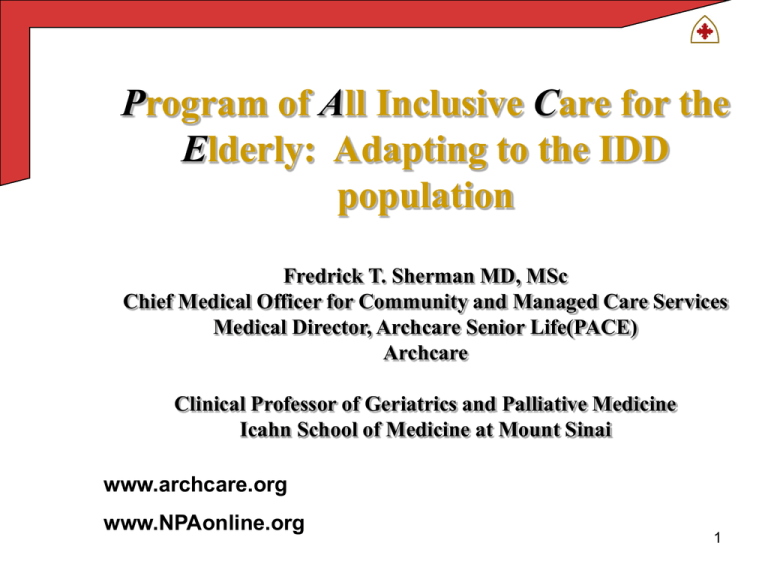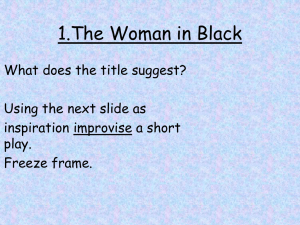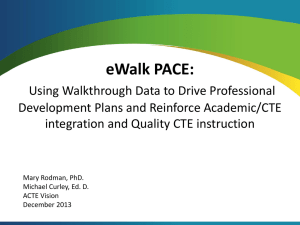
Program of All Inclusive Care for the
Elderly: Adapting to the IDD
population
Fredrick T. Sherman MD, MSc
Chief Medical Officer for Community and Managed Care Services
Medical Director, Archcare Senior Life(PACE)
Archcare
Clinical Professor of Geriatrics and Palliative Medicine
Icahn School of Medicine at Mount Sinai
www.archcare.org
www.NPAonline.org
1
2
PRIMARY CARE OF OLDER ADULTS
WITH MULTIPLE CHRONIC CONDITIONS
• * NOT COMPREHENSIVE
• * NOT EVIDENCE-BASED
• * NOT INTEGRATED
• * NOT EFFICIENT
3
Program of All Inclusive Care
for the Elderly
An integrated system of care for the frail
elderly that is:
•
•
•
•
•
Community-based
Comprehensive
Coordinated
Continuous
Capitated
4
The PACE Model
Who Does It Serve?
• 55 years of age or older
• Living in a PACE service area
• Certified as needing nursing home care
• Able to live safely in the community with
the services of the PACE program at the
time of enrollment
5
FIVE Pillars of PACE:
Concurrent, Continuous processes for care of
older adults with multiple chronic conditions
– *INITIAL COMPREHENSIVE ASSESSMENT AND
REGULAR REASSESSMENTS
– *PLAN OF CARE
– *CARE COORDINATION
– *ACTIVE INVOLVEMENT IN CARE BY PATIENT,
FAMILY, CAREGIVERS, AND STAFF
– *TRANSITIONAL CARE
6
Milestones in the PACE Model History
Demo.
First Center Project
1973
1978
Waivers/
Full Risk
1983
Ongoing
Waivers
1985
7
Milestones in the PACE Model History
Congress
First
Authorizes
Legislation
Authorizing Demonstration Permanent
Sites
Provider
PACE
Status
Demonstration Operational
Publication
of Interim
Final PACE
Regulation
First Program
Achieves
Permanent
PACE
Provider
Status
Balanced Budget Act
of 1997, H.R. 2015
Washington, D.C.
1986
1990
1997
(Nov)
1999
(Nov)
2001
8
Milestones in the PACE Model History
Publication of 2nd Interim
Final PACE Regulation
enhancing opportunities
for program flexibility
(Oct)
2002
Final PACE Rule
November 2006
9
PACE Programs Around the Nation
10
National Census Growth
1996 – 2012
11
PACE is Small in
Scale
Each PACE center and IDT can
serve up to about 200 enrollees.
12
Typical PACE Patient
– *Average age 80 years old
– *Takes 8 medications
– *90% are medically complex with 4 or more
chronic conditions, low income and dual
eligibles
– *50% are demented
– *50% are incontinent
– >50% are dependent in at least 3 ADLS
including bathing, dressing and toileting
13
Common Problems of Aging ID
populations
• Mental illness: depression, dementia, delirium, anxiety
• Neurological syndromes: Seizures increase in vascular
and Alzheimer’s dementia
• Pressure ulcers in dysmobile IDD patients
• Constipation
• Falls
• Dysphagia, GERD, dental erosions, esophagitis,
anemia, aspiration pneumonia
• Behavioral disorders: look first for pain or other medical
problems; use behavioral management techniques;
– Data poor on neuroleptics; GDR
14
15
What are health issues over past
decade in aging ID populations
Persons with ID survive and live in to late life
No studies on “multi-morbidity”
Polypharmacy studies are scarce
Cardiovascular disease and some cancers
less common
Environmental risks (lack of exercise,
overweight, obesity, and dental problems)
are increasing
16
Hospitalizations for I/DD: 1995-2001
• Mental Disorders: 33%
(schizoprenia,depression)
• Dental Disorders: 40% of day-surgery
admissions
• High ambulatory care sensitive
conditions: 3x greater than age/sex
adjusted general pop
• In-hospital surgery rates—low
• Highest hospitalization rates age 40-44
17
CHALLENGES FOR PRIMARY CARE
FOR IDD
• * COMMUNICATION ISSUES
• * CAREGIVER UNABLE TO PROVIDE
ESSENTIAL INFORMATION
• * FREQUENT RELOCATIONS
• *FEARFUL ABOUT PHYSICAL EXAM
AND TESTS
• *INCREASED # OF HEALTH ISSUES
• *EXTRA CLINICIAN TIME
18
The PACE Model
Philosophy
Honors what frail elders want
• To stay in familiar surroundings
• To maintain autonomy
• To maintain a maximum level of
physical, social, and cognitive function
19
Brief Overview of PACE
Services Provided
•nursing
•physical therapy,
•occupational therapy
•recreational therapy
•meals
•nutritional counseling
•social work
•medical care
•home health care
•personal care
•prescription drugs
•social services
•audiology
•dentistry
•optometry
•podiatry
•speech therapy
•respite care
Hospital and nursing home
care when necessary
20
Integrated Service Delivery and
Team Managed Care
Interdisciplinary Teams
Social Services
Pharmacy
Home Care
Activities
Nutrition
Nursing
OT/PT
Primary Care
Provider
Transportation
21
Integrated, Team
Managed Care
• INTERDISCIPLINARY TEAM (IDT)
MANAGED vs. individual case manager
• PLAN OF CARE implemented by IDT
• Continuous process of assessment,
treatment planning, service provision and
monitoring of PLAN OF CARE
• IDT focuses on preventive care, early
detection and aggressive intervention
22
Status of PACE Development
(as of December, 2012)
• Over 160 PACE centers, operated by 89
organizations, in 30 states, serving over
27,000 participants
• Between 2005 and 2010, number of
participants doubled
• Enrollment grew about 30% between
2009 and 2012
• 22 new programs in development
“pipeline” expected to open in 2013
23
PACE Provides
Transportation
24
PACE Provides PT & OT
25
PACE Core Competencies
Provider based model
Tightly controlled care management and
utilization systems
Serves largely a nursing home eligible
population in the community when enrolled
Good care outcomes, high enrollee
satisfaction and low disenrollment rates
Established existing program with a proven
track record
26
Capitated, Pooled
Financing
• Integration of Medicare, Medicaid and
private pay payments
• Medicare capitation rate adjusted for the
frailty of the PACE enrollees
27
Revenue Sources 2012
MEDICARE
$3,087 pmpm
39%
MEDICAID
$4,496 pmpm
57%
PRIVATE PAY
$274 pmpm
4%
Monthly Capitation
28
Source of Service Revenue
• PACE Programs receive approximately:
– 2/3 of their revenue from Medicaid
– 1/3 from Medicare
(A small percentage of program revenue comes from
private sources or enrollees paying privately)
• 2012 Mean Medicare PMPM Rate: $2,057
• 2012 Median Medicaid PMPM Rate: 3,343
• PACE Programs are Medicare D providers
29
PACE Costs
Jan – Dec 2012
30
Hospitalization Rates I
50%
43%
40%
All Medicare
30%
20%
20%
16%
Medicare 55+ with 3
ADL deficits
PACE
10%
0%
% Hospitalized/Year
Wieland, JAGS 2000; 48:13731380
31
Hospitalization Rates II
14
14
12
10
All Medicare
8
Medicare 55+ with 3
ADL deficits
PACE
6
4
2
2
2
0
Hospital Days/Year
Wieland, JAGS 2000; 48:13731380
32
Hospitalization Rates III
8
6.9
7
6
5
4
3
2.6
Massachusetts
Dually Eligible
Community LTC
Upham's Elder
Service Plan
2
1
0
Hospital Days/Year
Flanders, Personal
Communication, 2004
33
34
Length of Stay
8
7
6.6
6
5
4.1
All Medicare
PACE
4
3
2
1
0
Average Length of Stay (Days)
Wieland, JAGS 2000; 48:13731380
35
Nursing Home Placement
100.0%
100%
90%
80%
70%
60%
50%
40%
30%
20%
10%
0%
NH Certified
NH Placement
10.0%
36
Challenge for Providers
• Begin to think in terms of People vs.
Sentinel Events.
• Abandon the assumption that more is
better.
• Understand that not all aspects of care are
clinically based, some require simple
creativity.
• Embrace the importance of a consistent
care delivery system over time.
37
CAREGIVERS: PARENTS
• *Parents provide their IDD adult children
with a home throughout their life course
• *Parents age
• *Parents become sick, disabled, and need
care
• *Parents die
38
National PACE Association
Resources
• www.NPAonline.org
• Core Resources Set for PACE (CRSP)
(copyright NPA)
– Core operational program components (i.e. policies,
procedures and model materials)
– Model PACE provider applications
• Financial Planning Tools (copyright NPA)
–
–
–
–
Case studies of successful sites
Baseline Scenario
Financial Proforma and Users Guide
Business Planning Checklist
• Exploring PACE Membership Category
• Resources for States
39
Fredrick T. Sherman MD, MSc.
Chief Medical Officer
for Community and Managed
Care Services
Archcare
fsherman@archcare.org
Clinical Professor of Geriatrics
and Palliative Medicine
Icahn School of Medicine at
Mount Sinai
40







